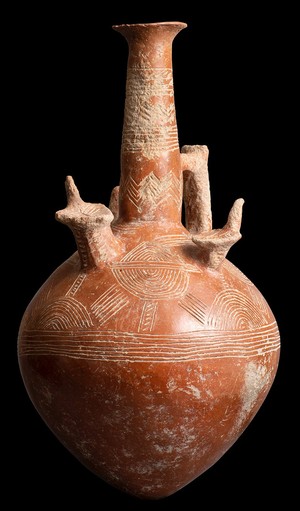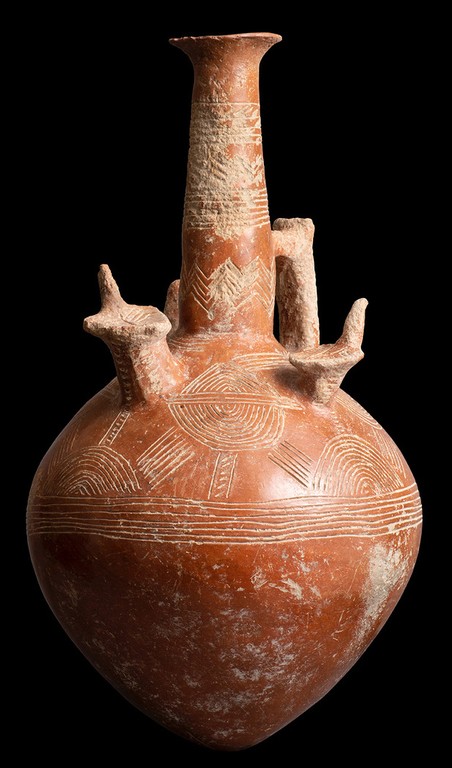Cypriot large flagon with 3 birds: Early Cypriot III (2100-2000 BC)
Large Flagon with 3 birds (Early bronze Age III) 2100 – 2000 BC
Large flagon probably made specifically for the funeral feast and possibly to serve wine or beer. Elaborate and impractical pieces such as this would have expressed and reinforced the status of the giver, and is especially known from the North, which developed a less egalitarian society than apparently continued in the South, perhaps due to the development of a copper smelting and distributing industry in the North foothills of the Troodos Mountains.
It has been argued by Priscilla Keswani that most dead bodies in this period were given a temporary simple, shallow burial till the flesh had disappeared from the bones at which stage, when the process of death had ended, the person was able to become an ancestor and their bones reburied (often with one or two others) in the kin-group tomb, cut out of the soft limestone. This would also have given the mourners time to make and assemble the gifts of pottery and bronze, gold etc, plus animals and alcohol for the feast - especially cattle, not otherwise much eaten due to their value in pulling the new ploughs. This pattern of double funerals is known from around the world to anthropologists and implies some degree of ancestor reverence. Early Bronze Age pottery often featured horned animals, believed to have been male fertility symbols: especially bulls, stags and goats. Later, though these still continued, birds become a feature. Possibly they represented the spirit. Alternatively it has been suggested that a kind of “sky burial” might sometimes have been used (as in Tibet now) where bodies were defleshed by carrion birds, but there is no proof of this.
I now have 4 large flagons of this approximate size and shape, and two slightly smaller.
Size: Height 50cm
((Ex Museum of Cyprus, Jacksonville, New Carolina, USA. Assembled by Dr Takay Crist after the Turkish invasion of North Cyprus and opened to the public as a museum in 1988. This century the museum has not made significant acquisitions. It consisted of antiquities, documents, maps paintings and artefacts and was endorsed and by the President of Cyprus and the ambassador, as saving the antiquities from the market and making them available to the public and for study. The sale of the entire museum collection Leland Little Auctions USA, 15th June 2018, (this piece lot )represents a betrayal of the trust of Cyprus and almost all record of the provenance and history of the pieces seems to have been lost, including their dates of all acquisition.)
(Aquired Charles EdeLtd (London))
DJ 182

